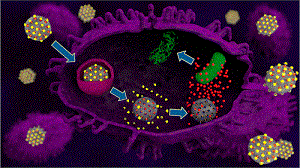 |
| A depiction of the mesoporous silica nanoparticle-based delivery system.--Courtesy ACS Nano |
Researchers at UCLA's California NanoSystems Institute have developed a nanoparticle delivery system that improves an antibiotic's ability to combat the bacteria Francisella tularensis, which the feds have classified as a potential bioterrorism agent.
The antibiotic containing the nanoparticles resulted in fewer bacteria in the lungs than traditional moxifloxacin injected at doses two to four times as high, at least in mice.
"F. tularensis survives and multiplies within macrophages, especially those in the liver, spleen and lung," said Marcus Horwitz, UCLA professor of medicine and microbiology, immunology and molecular genetics, in university news release. "Macrophages readily devour mesoporous silica nanoparticles, making these particles ideal for treating these types of infections."
"When you give a drug freely in the blood, only 1 or 2 percent of it gets to where you want it to go," he added. "With this system, the drug is contained inside the nanoparticles until they are inside macrophages, delivering a much larger amount of the drug directly to the site of infection."
As is often the case, a reduction in the dosage due to targeted drug delivery results in fewer side effects than higher doses delivered systematically.
The researchers said nanoparticles protect the drugs from metabolism and excretion following administration.
UCLA biochemistry professor Jeffrey Zink said the team tested many particles delivered at many pH values before settling on mesoporous silica nanoparticles.
"The nanoparticles are full of deep empty pores," Zink said in the release. "We place the particles in drug solution overnight, filling the pores with drug molecules. We then block the pore openings on the nanoparticle's surface with molecules called nanovalves, sealing the drug inside the nanoparticle."
F. tularensis causes the disease tularemia. Symptoms range from mild to life-threatening, and include a fever that can reach 104 degrees, according to the Centers for Disease Control and Prevention, which has classified the pathogen as a top-tier bioterrorism agent. It can also be acquired via exposure to infected animals and ticks.
More details can be found in journal ACS Nano.
- read the release from UCLA
- here's the paper abstract